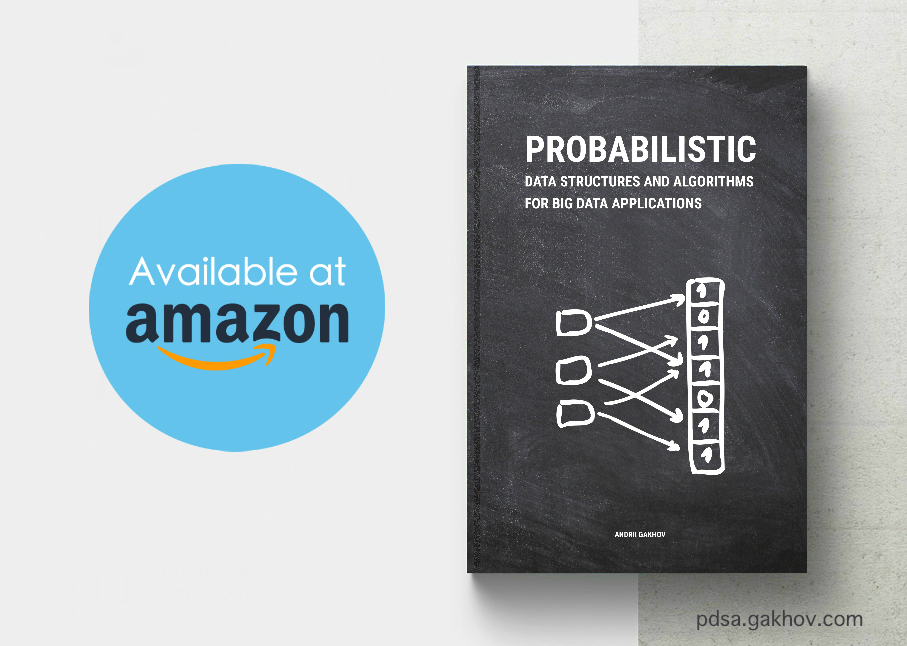| 1st, 2019 |
p. vii |
footnote "What Is Big Data?
https://www.ibm.com/software/data/bigdata/what-is-big-data.html" |
[removed] |
| 1st, 2019 |
p. 31 |
"... by bitwise XOR, however ..." |
"... by bitwise
AND
, however ..."
|
| 1st, 2019 |
p. 38, Algorithm 2.8 |
$$\mathbf{QF}[i] \gets prev[i]$$ |
$$\mathbf{QF}[i] \gets prev$$ |
| 1st, 2019 |
p. 41, Example 2.9 |
... \(16\)-bit fingerprints ... |
... \(32\)-bit fingerprints ... |
| 1st, 2019 |
p. 41, Example 2.9 |
$$h(x) = \text{MurmurHash3}(x) \bmod 16.$$ |
$$h(x) = \text{MurmurHash3}(x).$$ |
| 1st, 2019 |
p. 41, Example 2.9 |
$$p=13$$ |
$$p=29$$ |
| 1st, 2019 |
pp. 41, 43, Example 2.9 |
$$2^{13}$$ |
$$2^{29}$$ |
| 1st, 2019 |
pp. 42-45 |
... remainder \(f_q\) ... |
... remainder \(f_r\) ... |
| 1st, 2019 |
p. 62, Example 3.1 |
"... of unique elements is 23 GB." |
"... of unique elements is
2.3
GB."
|
| 1st, 2019 |
p. 65, Algorithm 3.2 |
$$\mathbf{Add}(e, LINEARCOUNTER)$$ |
$$\mathbf{Add}(x, LINEARCOUNTER)$$ |
| 1st, 2019 |
p. 66, Example 3.3 |
$$V = \frac{9}{16} = 0.5625$$ |
$$V = \frac{7}{16} = 0.4375$$ |
| 1st, 2019 |
p. 66, Example 3.3 |
"... which is pretty close to ..." |
"... which is close but overestimates ... |
| 1st, 2019 |
p. 66, Example 3.3 |
$$n \approx - 16 \cdot \ln{0.5625} \approx 9.206$$ |
$$n \approx - 16 \cdot \ln{0.4375} \approx 13.22$$ |
| 1st, 2019 |
p. 67 |
... a fixed constant \(O(N)\), where \(N\) is the total number of elements,
including duplicates. Thus, the algorithm has \(O(N)\) time complexity. |
... a fixed constant, and thus the algorithm has \(O(N)\) time complexity,
where \(N\) is the total number of elements, including duplicates. |
| 1st, 2019 |
p. 81, Formula 3.12 |
$$\hat n \approx \alpha_{m}\cdot m^{2} \cdot
\left(\sum_{j=0}^{m-1}2^{-COUNTER[j]}\right)$$ |
$$\hat n \approx \alpha_{m}\cdot m^{2} \cdot
\left(\sum_{j=0}^{m-1}2^{-COUNTER[j]}\right)^{-1}$$ |
| 1st, 2019 |
p. 96, Example 4.2 |
"... 500 billion ..." |
"... 500
m
illion ..."
|
| 1st, 2019 |
p. 109, Example 4.5 |
$$s_1(4) = 1,\text{ }s_2(4) = 1,\text{ }s_2(4) = -1.$$ |
$$s_1(4) = 1,\text{ }s_2(4) = 1,\text{ }s_3(4) = -1.$$ |
| 1st, 2019 |
p. 135, Example 5.3 |
"... remaining empty buffer \(B_{2}\)." |
"... remaining empty buffer \(B_{4}\)." |
| 1st, 2019 |
p. 159, Example 5.10 |
$$q(c_3) + \frac{1}{20} = \frac{6 + 11 + 1}{20} + \frac{1}{20} = 0.95,$$ |
$$q(c_3) - \frac{1}{20} = \frac{6 + 11 + 1}{20} - \frac{1}{20} = 0.85,$$ |
| 1st, 2019 |
p. 173, Example 6.8 |
$$c(d_1, d_4) = \frac{255 \cdot 0 + 0 \cdot 191 + 0 \cdot 255}{255 \cdot 255}
= 0$$ |
$$c(d_1, d_4) = \frac{255 \cdot 0 + 0 \cdot 191 + 0 \cdot 255}{\sqrt{255^{2}
+ 0^2 + 0^2} \cdot \sqrt{0^{2} + 191^2 + 255^2}} = 0$$ |




